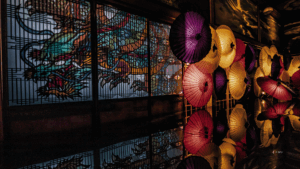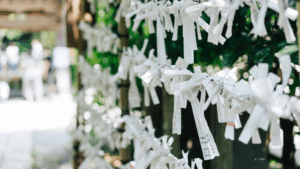From the famous temples of Kyoto to secluded shrines in the mountains of Tohoku, Japanese religious architecture conceals unexpected humor. Drunken dragons painted on the ceilings of solemn main halls, playful touches hidden in intricate carvings, and “surprise Buddhas” designed to startle worshippers—the ancient craftsmen of Japan had a “YABAI” sense of humor that continues to delight visitors today.
Sacred Jesters: The Hidden Comedians of Temple Art
While Buddhist temples may appear austere and serious at first glance, Japan’s master craftsmen often embedded subtle jokes and playful elements within their sacred creations. These weren’t acts of irreverence but rather expressions of a uniquely Japanese understanding that the sacred and the humorous could coexist harmoniously.
In Kyoto’s Tofuku-ji Temple, a 13th-century Zen masterpiece, one ceiling panel features what scholars affectionately call “The Drunken Dragon.” Unlike the fierce, dignified dragons depicted elsewhere, this creature appears cross-eyed and wobbly, as if it had spent too much time at a sake house. The master painter signed this particular panel, suggesting he took special pride in this moment of levity.
Surprise! The Jump-Scare Buddhas of Rural Japan
Perhaps the most literally “YABAI” examples of temple humor are the “Bikkuri Butsu” (Surprise Buddhas) found in smaller regional temples. These statues are designed with spring mechanisms or hidden compartments that reveal unexpected scenes when approached or touched.
At Kannon-ji in Aomori Prefecture, visitors who peer into what appears to be a traditional Buddha statue are startled when a skeleton pops up—a visceral reminder of impermanence that has been terrifying and delighting pilgrims for centuries. While seemingly macabre, these interactive religious “pranks” served important doctrinal purposes, using shock to drive home Buddhist concepts of impermanence.
Craftsmen’s Inside Jokes
The most subtle humor in Japanese temples exists in the form of inside jokes among the craftsmen themselves. Carpenters working on temple reconstructions occasionally left their marks in places only future renovators would find—faces carved into beams that would be hidden by roofing, or tiny figures engaged in comical activities tucked under floor supports.
In a recent renovation of Horyuji’s five-story pagoda, conservation specialists discovered a small wooden carving of a carpenter taking a nap, hidden inside a structural element. Carbon dating revealed it was from the original construction in 607 CE—evidence that workplace humor has remained remarkably consistent for nearly 1,400 years.
Universal Language of Laughter
What’s striking about these ancient expressions of humor is how familiar they feel to modern sensibilities. The playful subversion of expectations, visual puns, and situational comedy in these temple elements mirror the structure of modern memes and internet jokes with uncanny similarity.
When a temple craftsman carved a tanuki (raccoon dog) with comically large testicles as a hidden support beneath a Buddha statue, he was engaging in the same kind of absurdist humor that drives viral content today. These “YABAI” elements—surprising, slightly transgressive, yet ultimately good-natured—remind us that human humor transcends time and culture.
Experiencing Temple Humor Today
For visitors to Japan seeking these moments of ancient humor, I recommend looking beyond the obvious. Examine ceiling panels in lesser-visited halls of major temples. Ask local guides about any “unusual” features in regional shrines. And always check the underside of things—roof corners, statue bases, and structural elements often hide the most delightful surprises.
The humor embedded in Japan’s religious architecture reveals something profound about Japanese spirituality—that reverence and playfulness aren’t opposites but complementary aspects of a complete approach to the divine. In a culture that embraces contradictions and finds meaning in the space between opposites, even the most sacred spaces can contain moments of pure joy and laughter.



